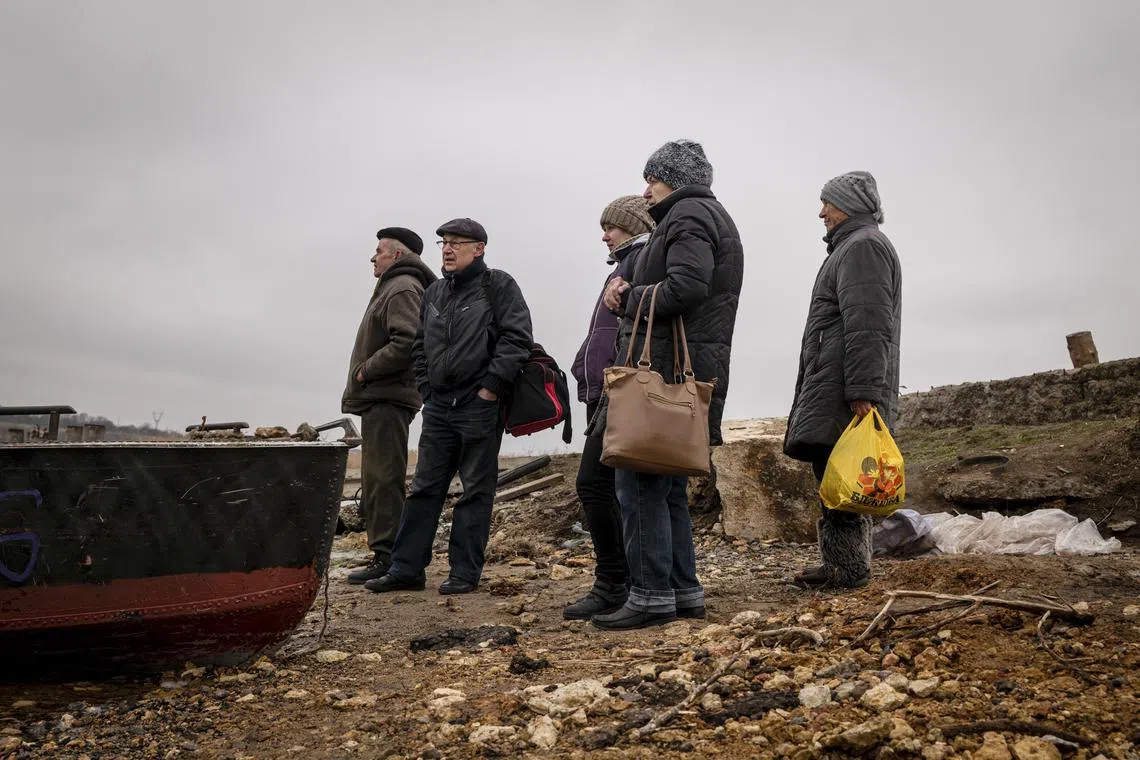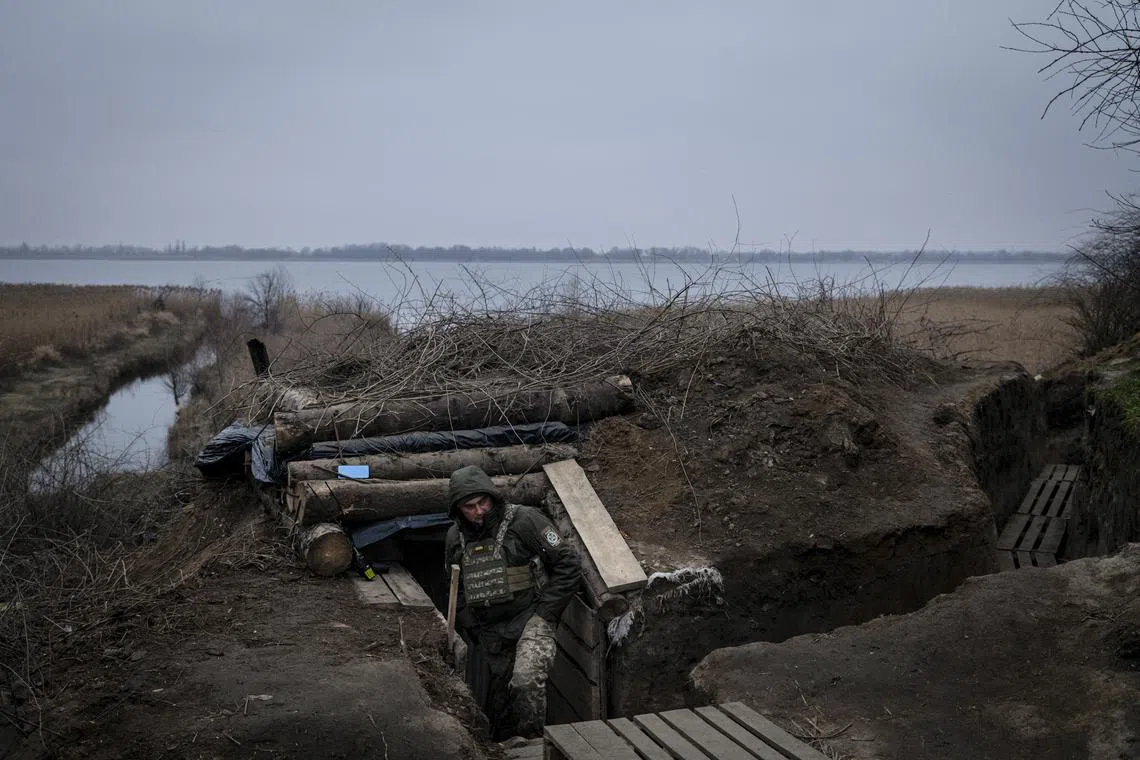‘Panic’ and shortages in parts of occupied Ukraine as Russia orders evacuation
Sign up now: Get ST's newsletters delivered to your inbox

On May 5, the occupation authorities in Ukraine's Zaporizhzhia region issued evacuation orders for 18 towns and villages.
PHOTO: NYTIMES
Follow topic:
KYIV – People living in Russian-occupied areas of southern Ukraine described in recent days an atmosphere of confusion, defiance and scarcity, as the occupation authorities ordered tens of thousands of civilians to evacuate in the face of a looming Ukrainian offensive.
The New York Times communicated with more than a dozen people in occupied towns and villages in the Zaporizhzhia and Kherson regions by phone and through secure messaging applications.
They said petrol stations were running dry, grocery store shelves were emptying and ATMs were out of cash.
“They discharge people from the hospitals and take away the equipment,” said Mr Andriy, 38, a resident of occupied Kamianka-Dniprovska in the southern region of Zaporizhzhia. “Then they close them. No one explains why and for how long. And people are afraid to ask since there are armed soldiers around.”
Access to occupied areas is heavily restricted, and residents’ accounts could not be independently verified.
Some of those interviewed were reached with help from exiled local officials, others through relatives in the capital Kyiv, or after they posted about the evacuation orders on social media.
With heavy fighting expected soon, the message from the occupation authorities has been clear for days: Leave now.
Most civilians fled the area long ago – primarily to Ukrainian-held territory.
But Ukrainians say that despite hardship and fear, most of those who remain are staying.
Last Friday, the occupation authorities in the Zaporizhzhia region – partially occupied by Russian forces, and one of the areas on the long front line where Ukraine could try to break through Russian defences – issued evacuation orders for 18 towns and villages, citing intensified fighting.
About 70,000 people in the region were expected to be moved, Kremlin-appointed regional official Andrey Kozenko told Russia’s state-run Tass news agency.
But it was not immediately clear where they would go.
While the evacuation was described as mandatory, there appeared to be little effort to force people to leave.
The occupation authorities have in the past presented mandatory evacuations as a humanitarian gesture, although an evacuation order in part of the Kherson region last autumn preceded a Russian military retreat.
In Zaporizhzhia, there is no indication of Russian troops withdrawing, according to Ukrainian military officials and Western military analysts.
They say Moscow’s troops continue to expand defensive fortifications, a sign they are digging in for combat.
Both sides in the war have stepped up strikes in recent days, as Ukraine says it is in the final stages of preparing a counter-offensive.
Russian forces unleashed their latest wave of aerial attacks on Ukraine overnight, including the biggest drone assault on Kyiv since the war began, officials said on Monday.
Ukraine’s military said it had shot down all 35 drones launched by Russian forces, including 30 over Kyiv, where at least five people were injured when drone wreckage fell onto buildings, Mayor Vitali Klitschko said.
After months of relatively sparse attacks on the city, Russia mounted four large assaults on Kyiv in May.

A Ukrainian soldier at the mouth of a bunker on Jan 23.
PHOTO: NYTIMES
For nearly four hours, Ukrainian air defence teams raced to shoot down the drones, lighting up the night sky with tracer fire from anti-aircraft guns, while residents huddled in bomb shelters and interior hallways.
Each time a drone was downed, an explosion rattled windows and shook buildings.
Russia also fired 16 missiles at the cities of Kharkiv, Kherson, Mykolaiv and Odesa, the Ukrainian military said on Monday.
The Ukrainian Red Cross said a warehouse storing its humanitarian aid was “destroyed” in the Odesa region.
In areas affected by Russian evacuation orders, few people appeared to be heeding them.
Mr Bohdan Starokon, exiled head of the Vasylivka district administration in the region, said about 80 of the roughly 5,000 people who remained in the town – out of a pre-war population of 22,000 – had agreed to evacuate on Sunday.
Ms Halyna, 58, a resident of the occupied town of Polohy, said the Russian authorities abruptly announced the end of the school year last Friday.
Scores of buses were brought in and residents told to board with only what they could carry, said Ms Halyna who, like others interviewed for this article, asked that only her first name be used because of safety concerns.
After the buses departed, she added, occupation authorities pulled aside parents who had refused to evacuate and forced them to sign papers acknowledging that they were informed of the risks and took responsibility for their actions.
The situation appeared particularly chaotic in the town of Enerhodar, home to many people who work at the Russian-occupied Zaporizhzhia nuclear power plant.
The United Nations’ nuclear watchdog agency warned at the weekend that evacuating Enerhodar could increase the risk of an accident at the facility and expressed alarm over the “increasingly tense, stressful, and challenging conditions for personnel and their families”.
The precarious situation at the plant has been a focus of international concern over the possibility of a major radiation release. It has been hit repeatedly by gunfire and shelling.
Many nearby residents have fled because of fighting in the vicinity.
Enerhodar’s exiled mayor Dmytro Orlov said on Sunday that conditions were deteriorating further, and that the evacuation order had caused “panic”.
Petrol stations were out of fuel, hospital equipment was being looted and the cost of medicine and supplies had “risen noticeably”, according to a Telegram post by Mr Orlov, who remains in contact with people there.
Mr Mykhailo, an Enerhodar resident, said in a text message that when residents went to one local store at the weekend, a Russian soldier approached them and said it was closed.
Asked when the store would reopen, Mr Mykhailo said, the soldier replied: “Never again.” NYTIMES

